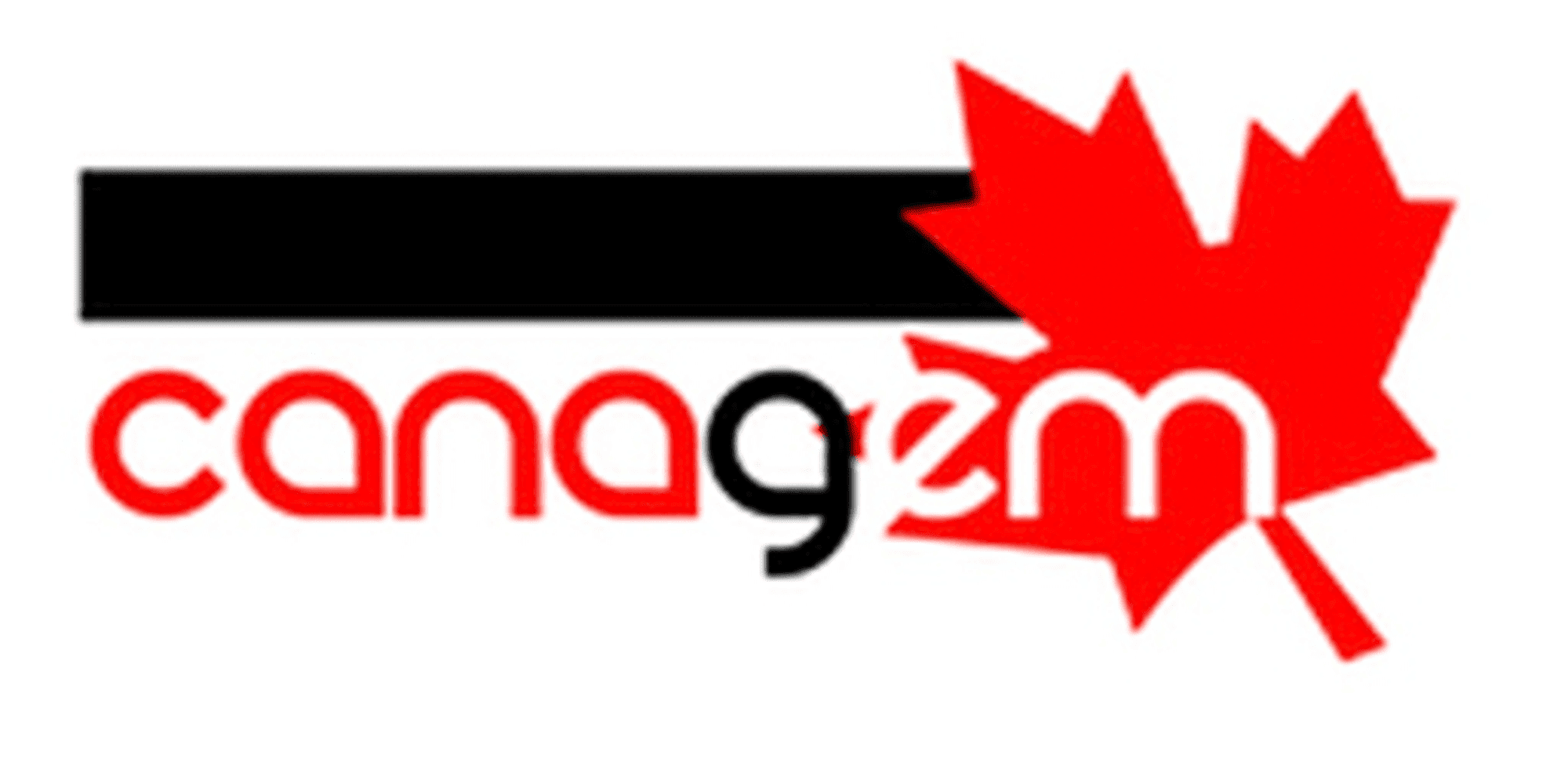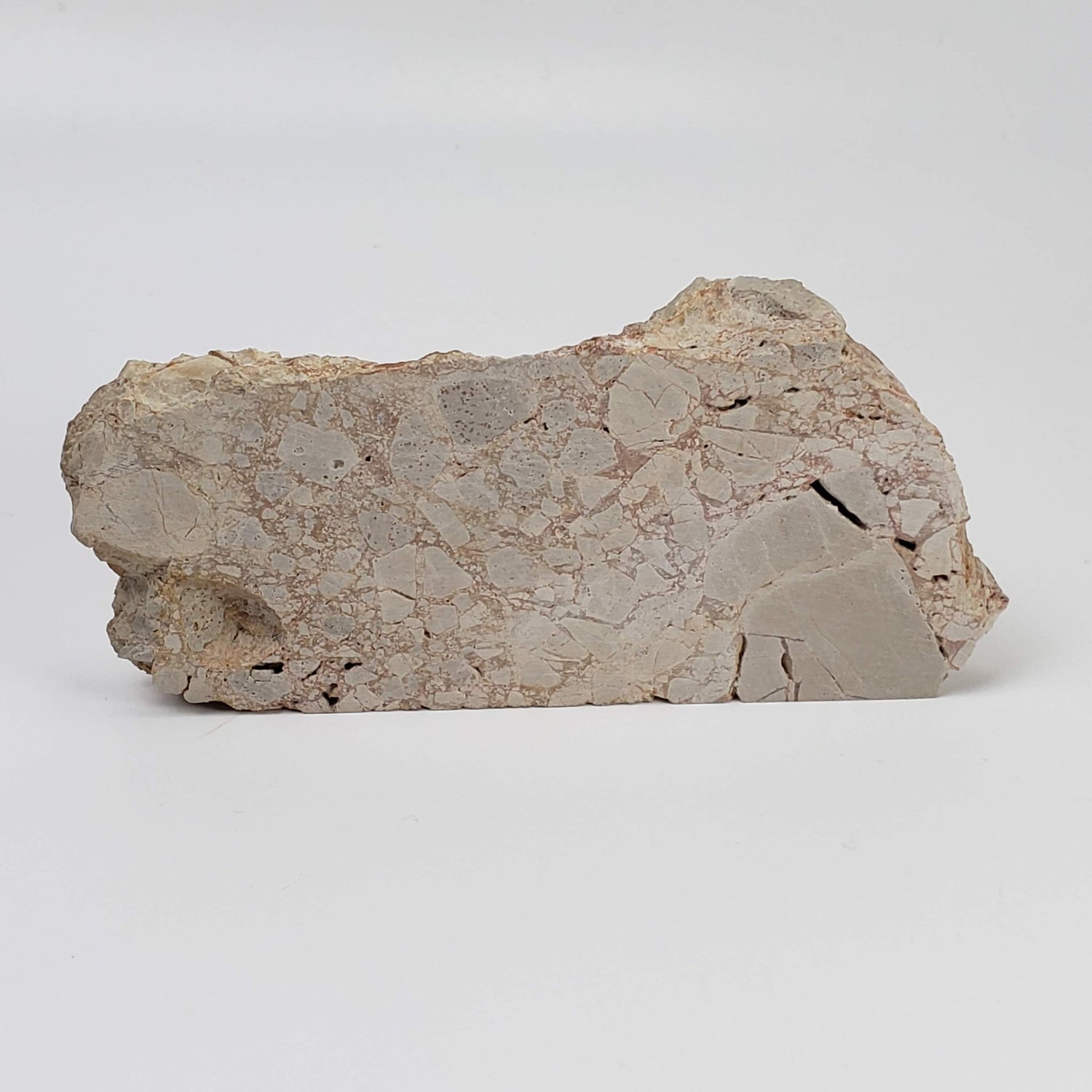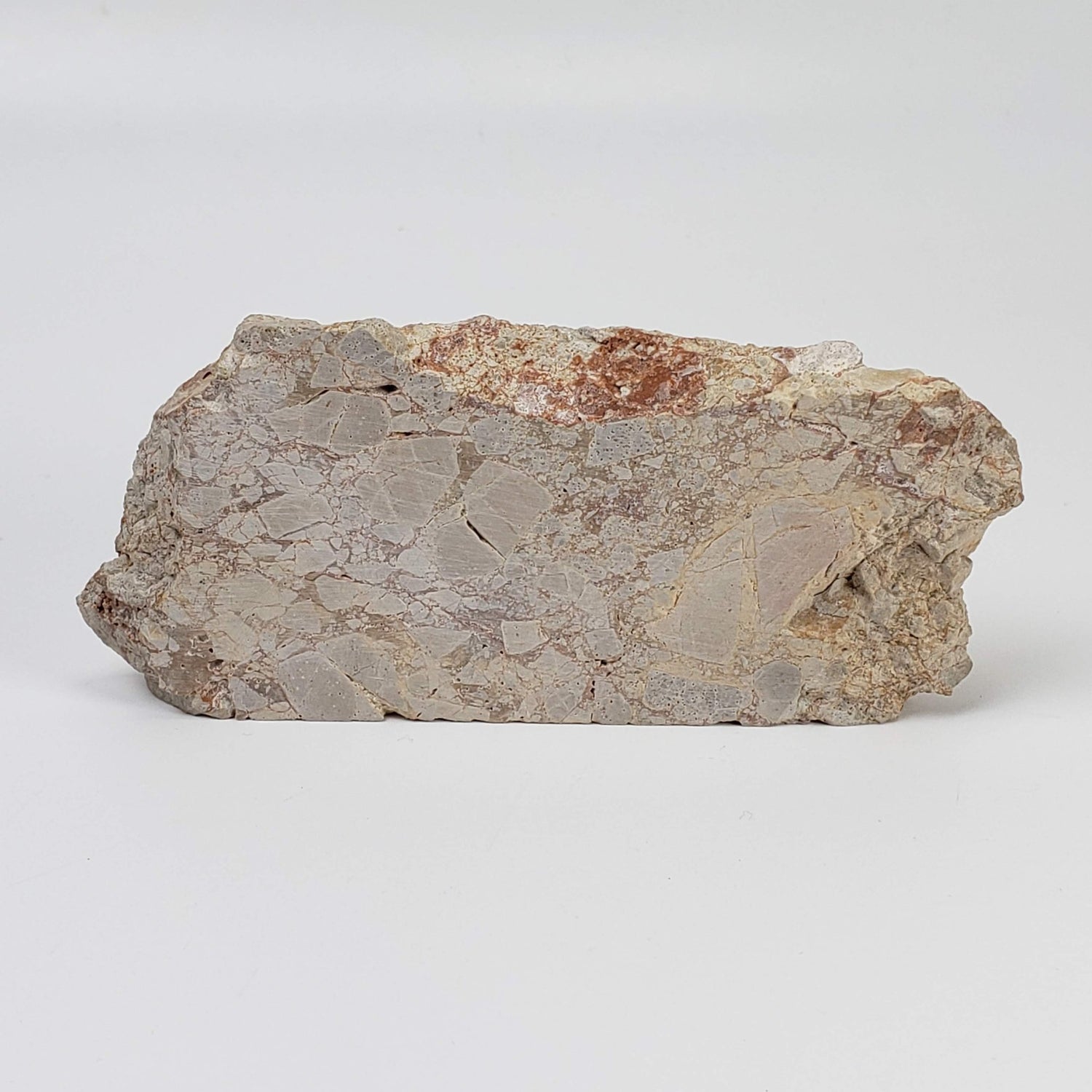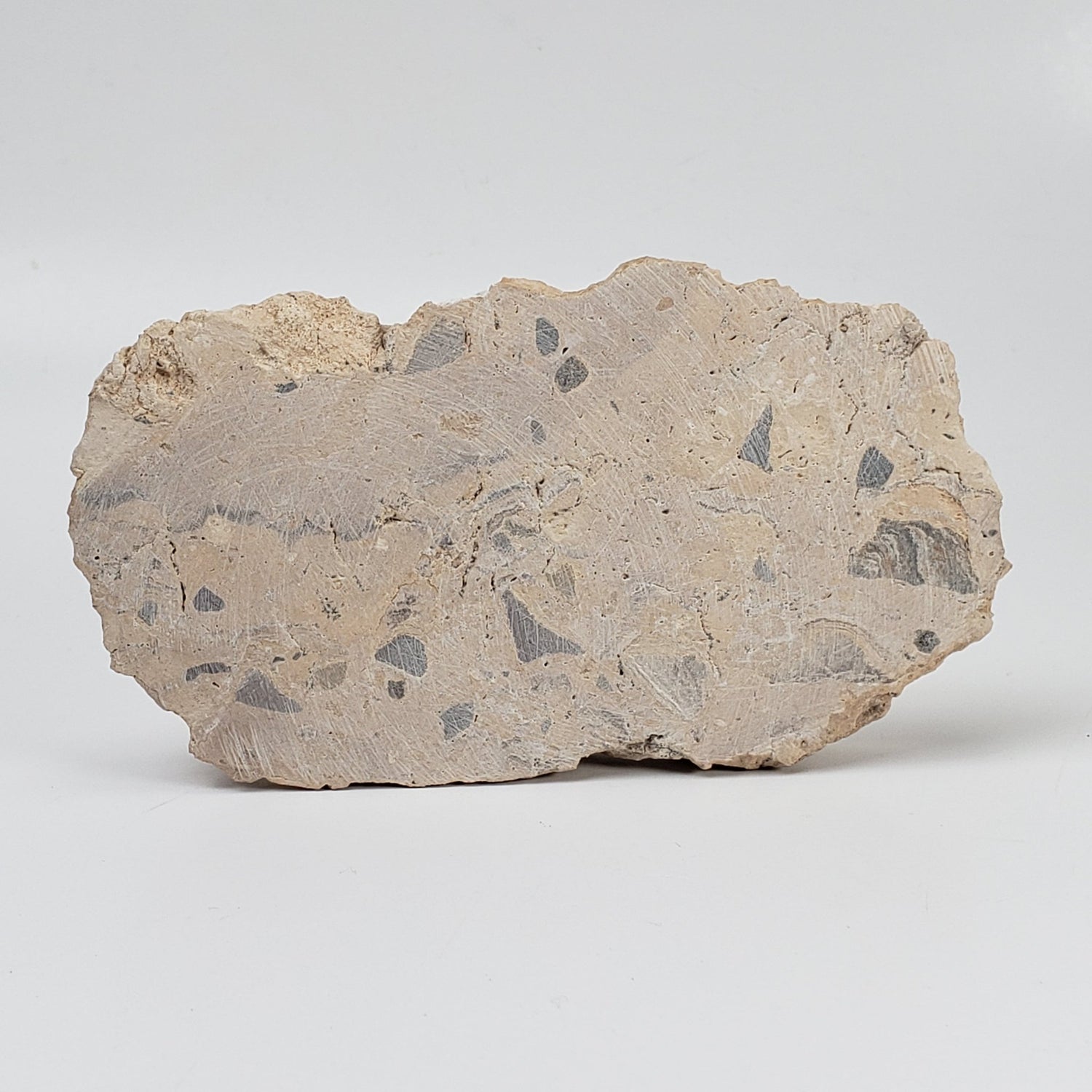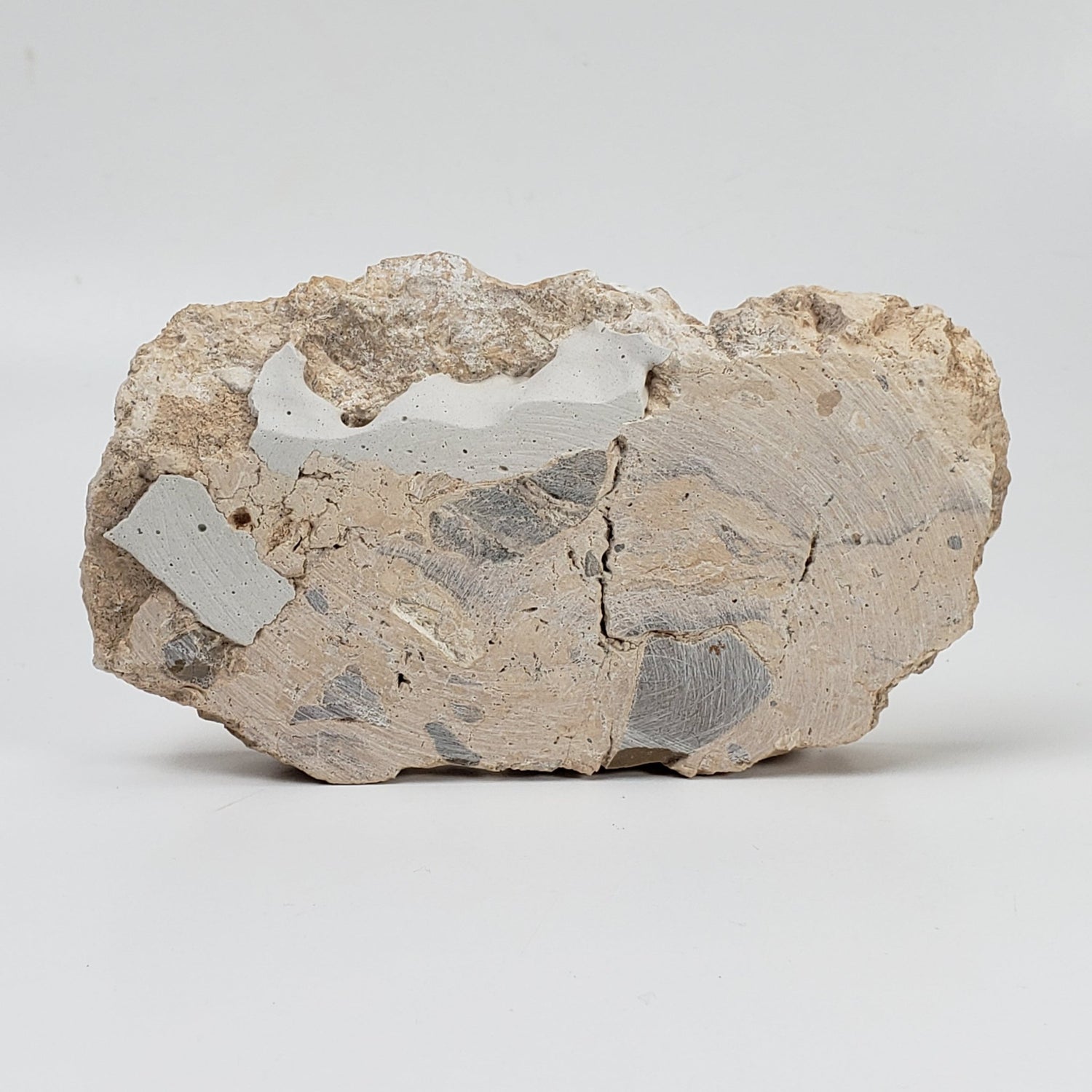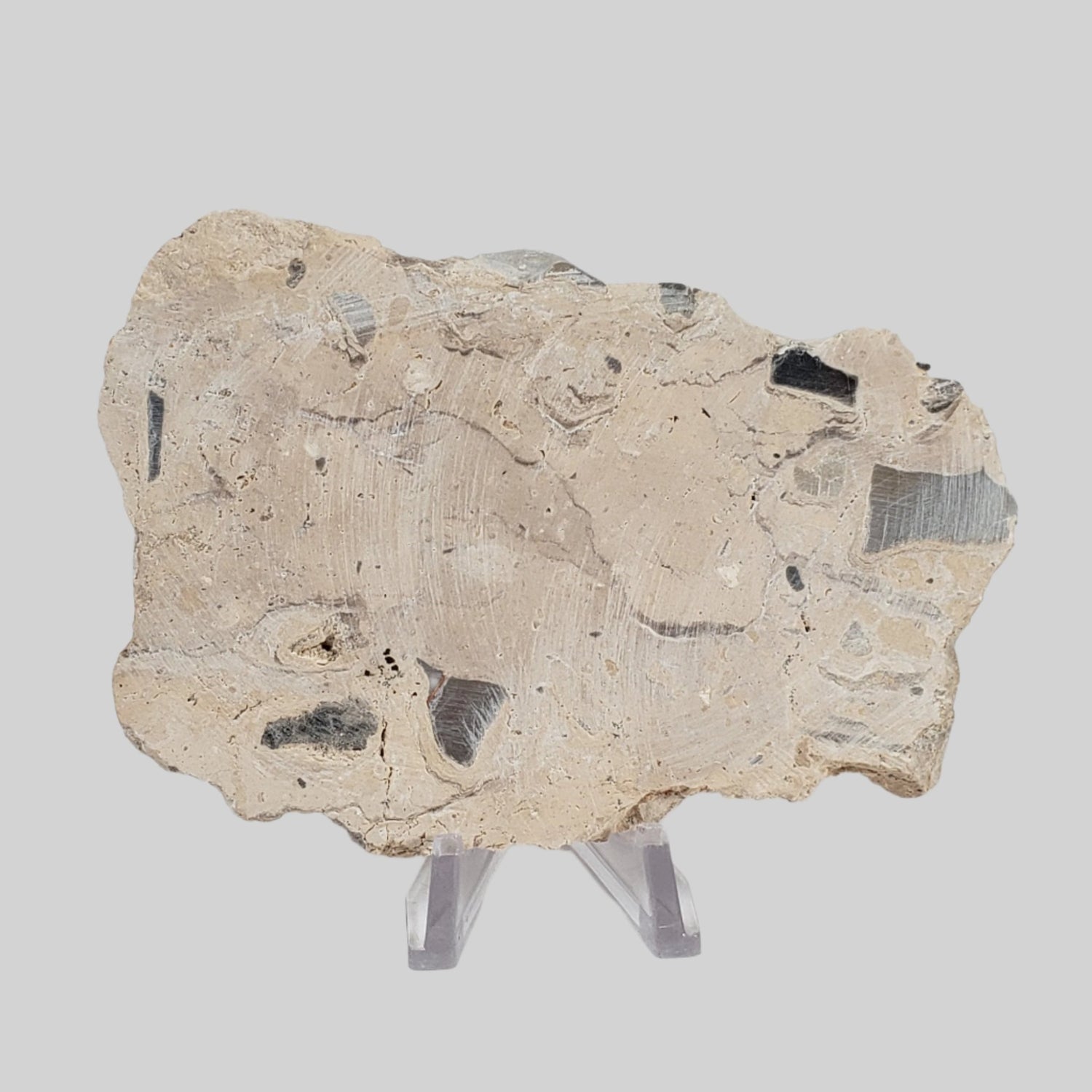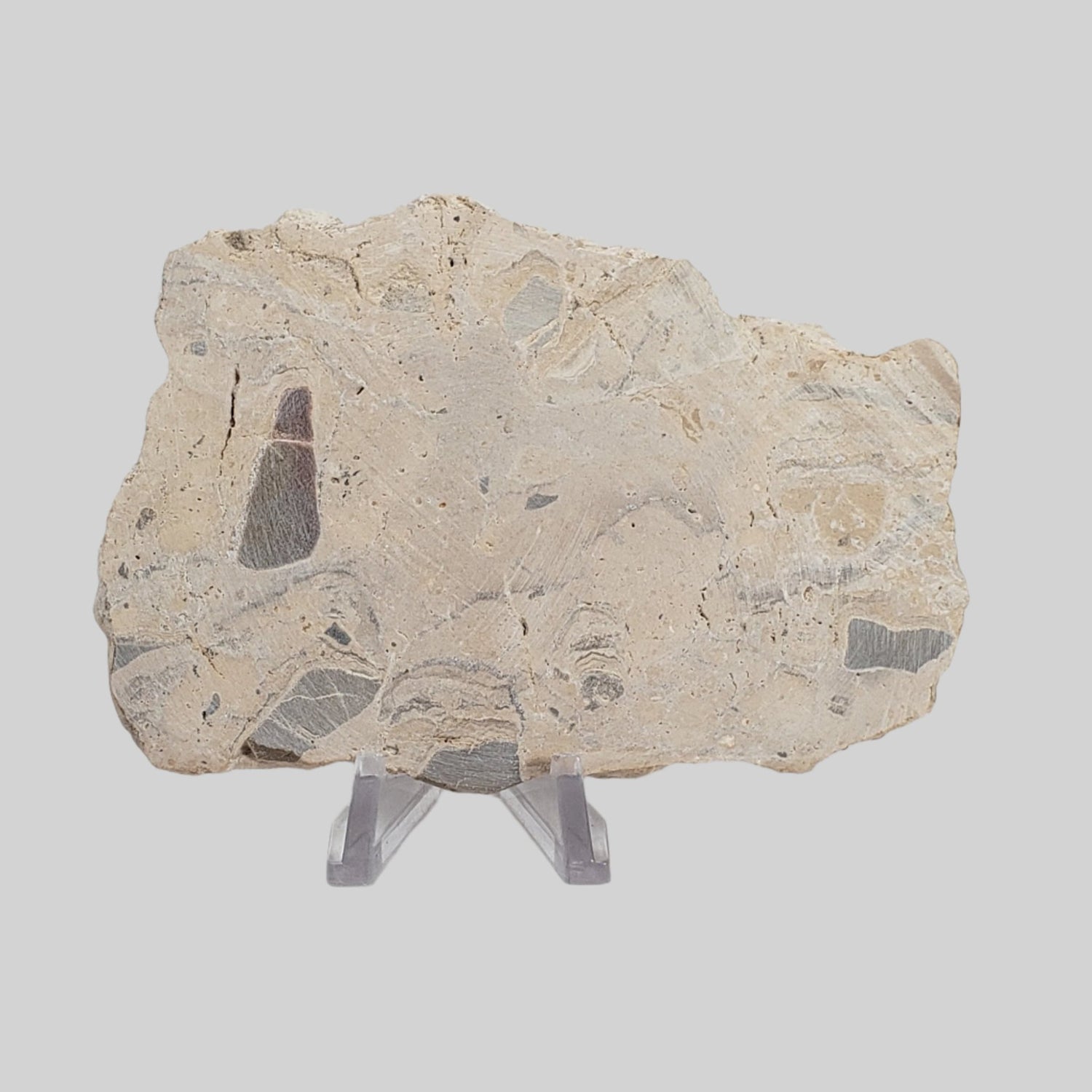Sort by:
109 products
109 products



Impact Melt Glass | Flädle Glass | 39.8 Grams | Lake Mien Crater Impactite | Sweden
$78.00 CAD
Unit price perImpact Melt Glass | Flädle Glass | 39.8 Grams | Lake Mien Crater Impactite | Sweden
$78.00 CAD
Unit price perThis is an outstanding specimen Impact Melt Glass, or "Flädle" glass, from the Lake Mien crater, 12 km (7.5 mi) southwest of the town of Tingsryd, Sweden. It weighs 39.8 grams and measures 54x49x20 mm. Although not a meteorite, impactites are directly linked to them and their impacts.
Impactite is a slag-like glassy object found on the surface of the earth, formed from rock melted by the impact of a meteorite. The term encompasses shock-metamorphosed target rocks, melts or suevites and mixtures of the two, as well as sedimentary rocks with significant impact-derived components and shocked mineral grains, tektites, anomalous geochemical signatures, etc.
This eroded crater is marked by a 5.5-km (3.4-mi) diameter circular lake named Lake Mien. The original crater rim is estimated to have been about 9 km in diameter before erosion. Its age is estimated to be 121.0 ± 2.3 million years (Early Cretaceous). This Suevitic breccia with clastic matrix and melt inclusions (black) and crystalline rock clasts (gray to white) is amazingly light considering its mass. It has a unique hollow sound when you tap it.
Would be a beautiful addition to any new or existing collection. Comes with a Canagem Collection specimen card.
This is a must have 506.7-gram Impact Melt Breccia, also referred to as Suevite, coming from Zipplingen and the famous Ries crater Germany. Although not a meteorite, impactites are directly linked to them and their impacts and are probably going to be one of the rarest collection items you'll ever own. Impactite is a slag-like glassy object found on the surface of the earth, formed from rock melted by the impact of a meteorite.
The term impactite encompasses shock-metamorphosed target rocks, melts or suevites and mixtures of the two, as well as sedimentary rocks with significant impact-derived components and shocked mineral grains, tektites, anomalous geochemical signatures, etc. This impactite was formed 14.5 million years ago in Malmian or Jurassic limestone when a meteorite crashed into the earth making a ~10 miles wide crater named the Ries crater in Germany. This gorgeous end piece displays very well and shows typical inclusions of glass bomb as the dark material and crystalline fragments visible throughout the specimen showing the stages of shock metamorphism.
It is amazingly light considering its mass of 130x109x37 mm. Would be a beautiful addition to any new or existing collection. Comes with a Canagem Collection specimen card.
This is a 418 gram impact melt rock from the Gallejaur Crater, northern Sweden. Although not a meteorite, impactites are directly linked to them and their impacts and are probably going to be one of the rarest collection items you'll ever own. Impactite is a slag-like glassy object found on the surface of the earth, formed from rock melted by the impact of a meteorite.
The term impactite encompasses shock-metamorphosed target rocks, melts or suevites and mixtures of the two, as well as sedimentary rocks with significant impact-derived components and shocked mineral grains, tektites, anomalous geochemical signatures, etc.
Rocks, interpreted as impact generated lithologies, occur in a large area surrounding the Gallejaur magnetic structure at latitude 65°10/longitude 19°30 in northernmost Västerbotten County in northern Sweden. These rocks comprise a variety of different types of breccias: authigenic The Gallejaur structure is located in the central part of the Skellefte mining district in the Precambrian Baltic Shield. The ca. 1.9 Ga old Skellefte district is an extensively mineralized, mainly felsic, submarine volcanic belt. The rocks are described as impact-generated, have been called the Vargfors Group and overlie the Skellefte volcanics and sediments with an angular unconformity. The youngest rocks in the area, intruding the Skellefte district supracrustals and probably the impact-generated rock, are A/I-type granitoids belonging to the Revsund-Adak granite suite, which have been dated at ca. 1.80 to 1.78 Ga.
This great bookend slab displays very well. It has a mass of 94x84x48 mm. Would be a beautiful addition to any new or existing collection. Comes with a Canagem Collection specimen card.


Impactite Breccia Suevite | 96.3 Grams | Chassenon, Rochechouart Structure, France
$138.00 CAD
Unit price perImpactite Breccia Suevite | 96.3 Grams | Chassenon, Rochechouart Structure, France
$138.00 CAD
Unit price perThis is a must have 96.3 gram Impact Breccia, also referred to as Suevite, from the famous Rochechouart impact structure in South Western France, near the village of Chassenon. Although not a meteorite, impactites are directly linked to them and their impacts and are probably going to be one of the rarest collection items you'll ever own. Impactite is a slag-like glassy object found on the surface of the earth, formed from rock melted by the impact of a meteorite.
Named after the town of Rochechouart, the Rochechouart impact structure is located on the western margin of the French Massif Central near the city of Limoges, approximately 350 km (220 mi) south of Paris. Rochechouart (population about 3800) is built with rocks created or modified by the impact (impactites). Chassenon, a third of the size of Rochechouart, is also built of impactites. Impactite was used 2000 years ago for building Chassenon's monumental Roman baths of Cassinomagus.
The very fine materials (impactoclastites) are preserved forming a very fine layered horizontal deposits on top of the melt rich suevite (breccia with a debris matrix and both rock debris and melt fragments as clasts) near Chassenon.
The term impactite encompasses shock-metamorphosed target rocks, melts or suevites and mixtures of the two, as well as sedimentary rocks with significant impact-derived components and shocked mineral grains, tektites, anomalous geochemical signatures, etc. This impactite was formed 186 million years ago. This deformed rock fragments and partly molten are imbedded in a melt matrix showing typical flow structures from former melt.
This gorgeous end cut displays very well with a mass of 89x62x19 mm. Would be a beautiful addition to any new or existing collection. Comes with a Canagem Collection specimen card.


Libyan Desert Glass | Natural Impact Glass | 8 Grams | Authentic Impactite
$43.00 CAD
Unit price perLibyan Desert Glass | Natural Impact Glass | 8 Grams | Authentic Impactite
$43.00 CAD
Unit price perThis is a rare and fantastic 8 gram Libyan Desert Glass from Kuffra, Libya, with dimensions of 32x22x15 mm.
Although its exact origin is still debated, the leading theory suggests it was formed by a high-energy event, such as a meteoric impact or airburst, that melted the desert sand directly where it lay, without being ejected into the atmosphere and re-entering. This results in different physical characteristics compared to tektites. Libyan Desert Glass is found specifically in the Great Sand Sea of the Eastern Sahara, within a more localized area spanning parts of western Egypt and eastern Libya.
This piece displays extremely well and is a quality translucent specimen. It has an aesthetic shape with a beautiful wind eroded body from the years spent in the Desert. Would be a beautiful addition to any new or existing collection. Comes with a Canagem Collection specimen card.


Impactite Breccia Suevite | 40.8 Grams | Chassenon, Rochechouart Structure, France
$58.00 CAD
Unit price perImpactite Breccia Suevite | 40.8 Grams | Chassenon, Rochechouart Structure, France
$58.00 CAD
Unit price perThis is a must have 40.8 gram Impact Breccia, also referred to as Suevite, from the famous Rochechouart impact structure in South Western France, near the village of Chassenon. Although not a meteorite, impactites are directly linked to them and their impacts and are probably going to be one of the rarest collection items you'll ever own. Impactite is a slag-like glassy object found on the surface of the earth, formed from rock melted by the impact of a meteorite.
Named after the town of Rochechouart, the Rochechouart impact structure is located on the western margin of the French Massif Central near the city of Limoges, approximately 350 km (220 mi) south of Paris. Rochechouart (population about 3800) is built with rocks created or modified by the impact (impactites). Chassenon, a third of the size of Rochechouart, is also built of impactites. Impactite was used 2000 years ago for building Chassenon's monumental Roman baths of Cassinomagus.
The very fine materials (impactoclastites) are preserved forming a very fine layered horizontal deposits on top of the melt rich suevite (breccia with a debris matrix and both rock debris and melt fragments as clasts) near Chassenon.
The term impactite encompasses shock-metamorphosed target rocks, melts or suevites and mixtures of the two, as well as sedimentary rocks with significant impact-derived components and shocked mineral grains, tektites, anomalous geochemical signatures, etc. This impactite was formed 186 million years ago. This deformed rock fragments and partly molten are imbedded in a melt matrix showing typical flow structures from former melt.
This gorgeous end cut displays very well with a mass of 50x46x18 mm. Would be a beautiful addition to any new or existing collection. Comes with a Canagem Collection specimen card.
Here we have for you a large 37.3 grams superbly shaped Indochinite Tektite from Maoming City, Guangdong Province, China. Although not a meteorite, tektite is directly linked to them or their impacts, just consider its age of around 780,000 years old.
Tektite can still be interesting because of the persistent mystery has that resisted clear explanations of their creation for generations of geologists. Dimensions are 60x22x21 mm.
This piece displays very well and is a very nice size showing multiple characteristics of its origin. Would be a beautiful addition to any new or existing collection. Comes with a Canagem Collection specimen card.
Here we have for you a large 51 grams superbly shaped Indochinite Tektite from Maoming City, Guangdong Province, China. Although not a meteorite, tektite is directly linked to them or their impacts, just consider its age of around 780,000 years old.
Tektite can still be interesting because of the persistent mystery has that resisted clear explanations of their creation for generations of geologists. Dimensions are 47x38x32 mm.
This piece displays very well and is a very nice size showing multiple characteristics of its origin. Would be a beautiful addition to any new or existing collection. Comes with a Canagem Collection specimen card.
The Azuara polymict impact breccia refers to the impact material from the 38 million year old twin (multiple) impact structures Azuara / Rubielos de la Cerida in Northern Spain.
This polymict impact breccia was found in the area of Santa Cruz de Nogueras near the center area of this large multiple impact structure. This is partly melted and/or decarbonized limestone fragments in a dense and extremely hard matrix showing flow texture. The breccia is considered an equivalent to suevite impactites in other impact structures. This beautiful slice has dimensions of 110x51x11 mm and weighs 122 grams.
Would be a beautiful addition to any new or existing collection. Comes with a Canagem Collection specimen card.
The Azuara polymict impact breccia refers to the impact material from the 38 million year old twin (multiple) impact structures Azuara / Rubielos de la Cerida in Northern Spain.
This impact breccia was found in the area of the village of Fuendetodos near the center area of this large multiple impact structure. This is partly melted and/or decarbonized limestone fragments in a dense and extremely hard matrix showing flow texture. The breccia is considered an equivalent to suevite impactites in other impact structures. This beautiful slice has dimensions of 115x63x13 mm and weighs 156 grams.
Would be a beautiful addition to any new or existing collection. Comes with a Canagem Collection specimen card.


Libyan Desert Glass | Natural Impact Glass | 2.6 - 3.9 Grams | Authentic Impactite
From $16.00 CAD
Unit price perLibyan Desert Glass | Natural Impact Glass | 2.6 - 3.9 Grams | Authentic Impactite
From $16.00 CAD
Unit price perChoose your Libyan Desert Glass! You will receive the exact piece you choose. This size of Libyan Desert Glass is great for jewelry making and a variety other small projects. They would also be a beautiful addition to any new or existing collection .
These rare and fantastic Libyan Desert Glass were found in a strewn field in the Western Desert of Egypt. The weight and dimensions of each piece are provided below.
The impact origin of Libyan Desert Glass is still disputed by some scientists and the exact impact site has not been located, although there is clear evidence that an impact has happened. The glass was discovered during an expedition of an international scientific community in 1932; and in 2013, a published analysis of a small black rock proposed that this sample was the remnant of a cometary impact.
The major component of Libyan Desert Glass is almost pure molten silica glass. Proof exists that Libyan Desert Glass had been used as a gemstone in the making of jewellery by the Pharaohs in ancient Egypt.
These pieces display extremely well and are quality translucent specimen. They have an aesthetic shape with a beautiful wind eroded bodies from the years spent in the Desert. Comes with a Canagem Collection specimen card. The weight and dimensions of each piece are as follows:
A - 3.9 gr / 20x15x11 mm
B - 3.0 gr / 25x17x7 mm
C - 2.8 gr / 24x16x9 mm
D - 2.6 gr / 26x14x8 mm
E - 3.0 gr / 21x21x9 mm


Impact Melt Glass | 231 Grams | Layered Melt Impactite | Sudbury Structure, Canada
$384.00 CAD
Unit price perImpact Melt Glass | 231 Grams | Layered Melt Impactite | Sudbury Structure, Canada
$384.00 CAD
Unit price perThis is a must have 231 gram Impact Melt Glass slice from the famous Sudbury Impact Structure in Ontario Canada. Its dimensions are 123x104x9 mm. Although not a meteorite, impactites are directly linked to them and their impacts and are probably going to be one of the rarest collection pieces you'll ever own.
About 1.87 billion years ago, an object from space 9 kilometers in diameter, slammed into Canada a little north of Sudbury, Ontario creating the second largest impact structure on the earth. This impact was equivalent to a billion tons of TNT; an impact so great that it cracked the earth, in fact they still have earthquakes because of it today!
The many mineral rich deposits and strange rock formations in such close proximity has attracted attention for 100's of years, long before its impact origin was known. Thomas Edison, for instance, built a lab on site and NASA Moonwalker "Gene" Cernan, who studied and collected geology samples as part of his pre-moon mission training.
Would be a beautiful addition to any new or existing collection. Comes with Canagem Collection specimen card.


Impact Breccia Slice Kit | 106 Grams | Impactite and Guide | Brent Crater Trail, Ontario, Canada
$105.00 CAD
Unit price perImpact Breccia Slice Kit | 106 Grams | Impactite and Guide | Brent Crater Trail, Ontario, Canada
$105.00 CAD
Unit price perThis is a must have slice of Brent pinkish gneiss impact breccia. It is roughly diamond shaped with dimensions of 140x75x8 mm and a weight of 106 grams. It comes together with a collectable twelve-page booklet, with paper a cover, entitled Brent Crater Trail: History of the Crater.
This 14x21.5cm fully illustrated collectible trail guide was published in 1998 and is a great introduction to the Brent Crater. It examines the history of the Brent Crater, discovered in 1951, one of Canada’s many meteorite impact craters. The crater itself is about 3.8 km in diameter and is estimated to be 396-million year old (+ or - 20 million years).
Long after a meteorite impact crater has begun to disappear from the landscape, a variety of impactites may remain. One variety is impact breccia, a mixture of shattered and sometimes melted rock.
Although not a meteorite, impactites are directly linked to them and their impacts and are probably going to be one of the rarest collection pieces you'll ever own. Would be a beautiful addition to any new or existing collection, also perfect as a gift for a young space enthusiast. Comes with a Canagem Collection specimen card.
The Azuara polymict impact breccia refers to the impact material from the 38 million year old twin (multiple) impact structures Azuara / Rubielos de la Cerida in Northern Spain.
This impact breccia was found in the area of the village of Fuendetodos near the center area of this large multiple impact structure. This is partly melted and/or decarbonized limestone fragments in a dense and extremely hard matrix showing flow texture. The breccia is considered an equivalent to suevite impactites in other impact structures. This beautiful slice has dimensions of 117x79x9 mm and weighs 163 grams.
Would be a beautiful addition to any new or existing collection. Comes with a Canagem Collection specimen card.


Black Onaping | 217 Grams | Impactite Breccia Slice | Sudbury Structure, Canada
$342.00 CAD
Unit price perBlack Onaping | 217 Grams | Impactite Breccia Slice | Sudbury Structure, Canada
$342.00 CAD
Unit price perThis is a must have 217.7 gram slice of Black Onaping Impact Fallback Breccia from the famous Sudbury Impact Structure in Ontario Canada. It's dimensions are 126x117x7 mm. Although not a meteorite, impactites are directly linked to them and their impacts and are probably going to be one of the rarest collection piece you'll ever own.
About 1.87 billion years ago, an object from space 9 kilometers in diameter, slammed into Canada a little north of Sudbury, Ontario creating the second largest impact structure on the earth. This impact was equivalent to a billion tons of TNT; an impact so great that it cracked the earth, in fact they still have earthquakes because of it today!
This specimen of Sudbury Black Onaping Breccia is a lithified fallback breccia composed of melt glass and country target rock fragments. This meteorite impact created a large mushroom cloud that fell back down to earth to create this breccia. "Bucky Ball Fullerine" with terrestrial carbon in the form of C-60 and C-70 is found in this type of Sudbury impact rock. Greenish-Blueish dust covered Tektites can also be found within its matrix. The Onaping forms in two layers, the first one is grey and second one is black.
The many mineral rich deposits and strange rock formations in such close proximity has attracted attention for 100's of years, long before its impact origin was known. Thomas Edison, for instance, built a lab on site and NASA Moonwalker "Gene" Cernan, who studied and collected geology samples as part of his pre-moon mission training.
Would be a beautiful addition to any new or existing collection. Comes with a Canagem Collection specimen card.


Black Onaping | 191 Grams | Impactite Breccia Slice | Sudbury Structure, Canada
$302.00 CAD
Unit price perBlack Onaping | 191 Grams | Impactite Breccia Slice | Sudbury Structure, Canada
$302.00 CAD
Unit price perThis is a must have 191.39 gram slice of Black Onaping Impact Fallback Breccia from the famous Sudbury Impact Structure in Ontario Canada. It's dimensions are 116x115x6 mm. Although not a meteorite, impactites are directly linked to them and their impacts and are probably going to be one of the rarest collection piece you'll ever own.
About 1.87 billion years ago, an object from space 9 kilometers in diameter, slammed into Canada a little north of Sudbury, Ontario creating the second largest impact structure on the earth. This impact was equivalent to a billion tons of TNT; an impact so great that it cracked the earth, in fact they still have earthquakes because of it today!
This specimen of Sudbury Black Onaping Breccia is a lithified fallback breccia composed of melt glass and country target rock fragments. This meteorite impact created a large mushroom cloud that fell back down to earth to create this breccia. "Bucky Ball Fullerine" with terrestrial carbon in the form of C-60 and C-70 is found in this type of Sudbury impact rock. Greenish-Blueish dust covered Tektites can also be found within its matrix. The Onaping forms in two layers, the first one is grey and second one is black.
The many mineral rich deposits and strange rock formations in such close proximity has attracted attention for 100's of years, long before its impact origin was known. Thomas Edison, for instance, built a lab on site and NASA Moonwalker "Gene" Cernan, who studied and collected geology samples as part of his pre-moon mission training.
Would be a beautiful addition to any new or existing collection. Comes with a Canagem Collection specimen card.

